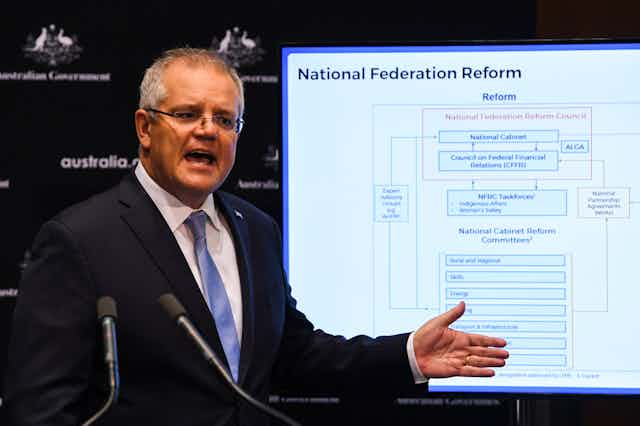Scott Morrison has won support for a major restructure of federal-state architecture which scraps the Council of Australian Governments, enshrines the “national cabinet” permanently, and pares down a plethora of ancillary ministerial bodies.
The Prime Minister is shaping the ongoing national cabinet around his government’s central priority of jobs, and strengthening the government’s grip on Commonwealth-state relations.
“The national cabinet will be driven by a singular agenda, and that is to create jobs,” Morrison said on Friday.
This would be its “laser-like” mission as the country came out of the COVID crisis and went into the years ahead. The national cabinet would “drive the reform process” between federal and state governments “to drive jobs.”
It would oversee ministerial cabinet subcommittees in key areas, including rural and regional, skills, energy, housing, transport and infrastructure, population and migration, transportation and “health, in terms of having a healthy workforce and a healthy community to support a strong economy”.
The changes, agreed at Friday’s national cabinet meeting, follow the success of that body since it was set up to deal with the pandemic.
“By any measure, national cabinet has proven to be a much more effective body for taking decisions in the national interest than the COAG structure,” Morrison said.
Although like COAG the national cabinet includes federal and state leaders, it has not been hampered by so much bureaucracy. Whether what’s regarded as excessive bureaucracy can be prevented from accumulating when there’s not a crisis remains to be seen.
Nor is it clear whether partisan federal-state politicking, which has been missing at national cabinet despite some sharp disagreements, will get back to previous levels in normal times.
The national cabinet is bound by cabinet confidentiality, which likely will work to the federal government’s advantage.
It will continue to meet regularly - fortnightly at the moment and later monthly - and “initial reform areas” will be agreed by it.
Mostly it won’t meet in person but by “telepresence”. Morrison said the virtual meetings during the pandemic had worked incredibly well. He said there would be two face-to-face meetings a year.
It will draw on a wider range of experts than just public servants.
Federal and state treasurers, who already meet regularly, will become a council of federal financial relations (CFFR). They will take responsibility for all funding agreements including national partnership agreements, and look to consolidating some of them.
The reshaped model cuts down the access of local government, the representative of which has been a permanent participant in COAG.
In the new system, once a year the national cabinet, the CFFR and the Australian Local Government Association will meet in person as the national federation reform council. This will discuss federation reform and “priority national federation issues such as Closing the Gap and women’s safety.”
Closing the Gap and women’s safety will also be on the agenda of national cabinet throughout the year.
Some 20 ministerial councils, which currently range from the regional ministerial forum to the ministerial forum on vehicle emissions, are to be consolidated. Another nine ministerial regulatory councils, presently ranging from energy to consumer affairs, are also to be reduced in number and streamlined; they are to focus on areas of key responsibilities.
Morrison said: “It’s important that ministers at state and federal level talk to each other but they don’t have to do it in such a bureaucratic form with a whole bunch of paperwork attached to it.
"They need to talk to each other, share ideas, but the congestion-busting process we’re engaged on here is simplifying that. They come together to solve problems, deal with issues and move on. They should talk to each other because they find value in it, not because of the requirements of some sort of bureaucratic process”.

